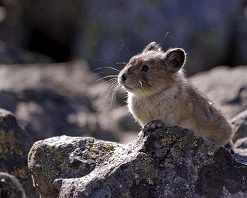
American Pika are living at lower elevations and surviving warmer temperatures than previously thought, according to a paper in the journal Arctic, Antarctic, and Alpine Research (available for download at the US Forest Service Pacific Southwest Research Station’s site).
One of the authors, Connie Millar, said she saw pika far more often and in a broader elevation range than she had expected she would. Millar, a Forest Service ecologist, found all those pika using a method she developed to quickly determine if pika are living in places where one would expect to find them.
Pika, cute little rabbit relatives that live in high elevations throughout the West, have been in the news lately. The Center for Biological Diversity (CBD) petitioned for the pika to be listed under the federal Endangered Species Act in 2007, citing climate change as a threat to survival of the cold-adapted species. Last month, under a new administration, the U.S. Fish and Wildlife Service decided not to protect the pika, explaining that though some populations do seem to be in trouble, most are doing fine so far. (Climate Watch has followed the pika story; see previous posts here, here, and here).
This newest study would seem to support the federal decision. But Shaye Wolf, staff biologist with the CBD, says that though the study “provides a snapshot of where pika are now, long-term in-depth studies have found that pika populations are declining.”
The majority of those declining populations are in Nevada’s Great Basin, at relatively low elevations for pika colonies. One paper Wolf cites was recently published in Ecological Applications. Authors Erik Beever and Chris Ray concluded that shrinking pika populations in the Great Basin could be partially attributed to climate change. Pika have an extremely narrow band of temperature tolerance and can suffer heat stroke in temperatures comfortable to humans.
Wolf and Millar are both members of the California Pika Consortium, a newly formed research group. Millar plans to distribute her pika survey to colleagues in the consortium in order to continue gathering data on locations of pika colonies.
Meanwhile, even though the Fish and Wildlife Service has denied federal protection to the pika, CBD is still working on gaining state-level protection in California. CBD biologists consider the pika to be a bellwether species for climate change.
3 thoughts on “(Some) Pika Persist at Low Elevations”
Comments are closed.

That’s funny Molly. The report you link is titled
“American Pika are thriving in the Sierra Nevada and southwestern Great Basin”.
New research documents that American pika in the Sierra Nevada and southwestern Great Basin are thriving and persist in a wider range of temperatures than previously discovered.
But that’s so different then your copy. “(Some) Pika Persist at Low Elevations” sounds like a funeral dirge (Somewhat).
Why are you coloring this happy news with your dirty prejudices? Wipe off your conscious and report the truth.
James,
Thanks for your comment.
Yes, the first report is good news. Pika seem to be more resilient and adaptive than some had feared. However, they’re not thriving across their entire range. If you take a look at the second report, you’ll see that some pika populations are struggling. Hence the title (and the parentheses)–I was aiming not to be misleading in either direction. I’m sorry if that didn’t come across.
I have seen articles “Islands in the Ski” and resent KEZI TV Eugene OR. about the pika decline, do you know of any pika studies in the Lewis Mt, NV (9,600′)area?.
Derrick